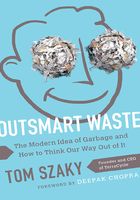
Useful versus Useless Outputs
Why is it that garbage exists in the human system but not more broadly in nature? Nature is a beautiful harmony of systems whereby every system’s output is a useful input for other systems. An acorn that falls from a tree is an important input for a squirrel that eats it. The by-product of that delicious meal—the squirrel’s poop—is an important input for the microbes that consume it. The output of the microbes—rich humus and soil—is in turn the very material from which a new oak tree may grow. Even the carbon dioxide that the squirrel exhales is what that tree may inhale. This cycle is the fundamental reason why life has thrived on our planet for millions of years. It’s like the Ouroboros—the ancient symbol depicting a serpent eating its own tail; in a way, nature truly is a constant cycle of consuming itself.
Even we humans, up until about a century ago, lived our lives in the same way: all of our outputs—from the carbon we exhaled to our feces and product waste—were cycled by nature until they became useful inputs again.
Yet today much of our waste breaks this age-old cycle by not being useful to any living organism. In the past century, the raw materials that make up our products have changed from easily degradable animal, plant, and other natural sources to highly refined, typically non-renewable resources (primarily oil). Today even when we use renewable resources (like trees), we typically render them useless outputs (like a used coffee cup) that cannot be easily recycled (due to the thin plastic lining on the inside).
This transition represents the first time in history that a species has moved away from a circular material supply chain—where every output in nature is cycled through multiple organisms until it becomes an input again—toward a linear one.
input Something that is used as food or raw material for an organism. Example: an acorn for a squirrel.
output Something that leaves an organism and is no longer useful to it. Example: one’s poop.
Take, for example, the plastic bag that may have been given to you when you bought this book. The useful life of a plastic bag is perhaps an hour or two—in other words, about the time it takes you to travel from the mall to your home. After that one trip, the bag typically ends up in your garbage on its way to the local landfill. Once at the landfill, it stays there, in some form, virtually forever.
Plastics, due to their molecular stability, do not easily break down into components useful to nature. Some estimates show a plastic bag taking 500 to 1,000 years to degrade. We say “estimates” because Alexander Parkes invented the very idea of plastic in 1856, and not enough time has passed for any plastics to fully degrade.
We say “estimates” because Alexander Parkes invented the very idea of plastic in 1856, and not enough time has passed for any plastics to fully degrade.
Additionally, a plastic bag does not just degrade like a banana peel, which is consumed by a variety of hungry microbes. Instead the plastic bag photodegrades—a process whereby the bag breaks apart into smaller and smaller pieces. The resulting particles are deadly when ingested by living things and can also contain pollutants like polychlorinated biphenyls (PCBs) and endocrine disrupters. Worse yet, they often resemble food, like zooplankton, and are inadvertently consumed by animals, such as jellyfish, who mistake the harmful materials for lunch.
product waste An object that itself (not its packaging) becomes waste. Example: a toothbrush or dry pen.
But the story of garbage doesn’t end with a few dead jellyfish. The United Nations Environment Programme (UNEP) estimates that there are 46,000 pieces of plastic floating in every square mile of our oceans; this material, after damaging the aquatic ecosystem, may somewhat ironically end up in our order of sushi or fish-and-chips—potentially helping us get cancer earlier in life. This is just one of the many possible consequences of throwing out product waste. A recent report from a cooperative that includes UNEP and the World Health Organization (WHO) said that more than 800 man-made chemicals, including bisphenol A (BPA), were found in products we consume every day.
this material, after damaging the aquatic ecosystem, may somewhat ironically end up in our order of sushi or fish-and-chips—potentially helping us get cancer earlier in life. This is just one of the many possible consequences of throwing out product waste. A recent report from a cooperative that includes UNEP and the World Health Organization (WHO) said that more than 800 man-made chemicals, including bisphenol A (BPA), were found in products we consume every day.